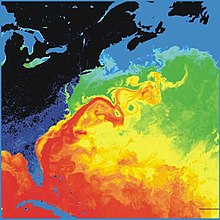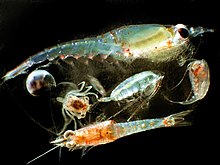Cold core ring


Cold core rings are a type of oceanic
Formation
The governing forces of an eddy are very dependent on its size. Small eddies are largely governed by viscosity and direction of the flow of a water body.
Permanent and semi-permanent cold core rings
Semi-permanent and permanent eddies are also relatively abundant throughout the world. These permanent and semi-permanent rings often form systematically in the same manner and often with the same drift and properties.[5] Some permanent eddies are regular enough to be given names within the ocean current system such as the cold-core Agulhas Ring off the tip of South Africa. Western boundary currents like the Agulhas, Brazil, and East Australian Currents are known for shedding eddies downward off from their ending points.[6] A semi-permanent cold-core eddy is periodically formed by the Loop Current in the eastern Gulf of Mexico, where warm water from the South Equatorial Current travels upwards through the south Caribbean ocean and flows into the Loop Current off the coast of Cancun.[7]
Characteristics and structure
Despite being surrounded by the highly saline and generally nutrient devoid waters of areas in the middle of oceanic gyres, cold core rings, especially those found in the Sargasso sea from the gulf stream, as mentioned before, have the ability to transport the nutrients and biota of the colder regions from which they originated into the warmer regions into which they travel. In Gulf Rings, the transport of nutrients facilitated by the cold core rings may be instrumental in sustaining the reduced productivity of the Sargasso Sea. As such, the cold core rings formed off the Gulf Stream is likely to influence the widespread distribution of zooplankton. Although the size of cold core rings can vary, their size typically varies from 100 to 300 kilometers, and travel at a speed of 150 centimeters per second.
All eddies are capable of transporting energy, momentum, heat, physical and chemical water properties, and even small organisms across very large distances, even when surrounded by waters that would not be conducive to the same.[4] Since eddies mix waters with different properties, they act as an exchange of nutrients from the continental shelf to the deeper ocean with differing properties as they travel. This makes them ideal locations for primary productivity, especially in areas of low nutrients, such as the center of open ocean gyres,[2] such as the Sargasso sea. The importance of these swirling masses lies in the incredible amount of kinetic energy they are able to transport both horizontally and vertically, their participation in air-sea interaction, and the irreversible mixing of water masses. These processes all contribute to the transfer of nutrients, oxygen, and trace chemicals, ocean stratification and density fields, and patterns of warmth that drive atmospheric and oceanic circulation.[3]
Transportation and habitation of organisms

In a study conducted in 1993, it was shown that cold core rings had the ability to transport species such as medusae and siphonophores and that even while surrounded completely by a warmer body of water, the medusae that was abundant outside of the cold core ring was not abundant within, and vice versa, showing that the conditions within and without of the cold core ring are conducive to certain species of medusae that otherwise would not be able to thrive in the original waters.[8]
See also
References
- JSTOR 24825670.
- ^ ISBN 9780123744739.
- ^ S2CID 28248509.
- ^ .
- .
- hdl:11427/34533.
- ^ Biggs, Douglas C.; Zimmerman, Robert A. (1997). "Note on plankton and cold-core rings in the Gulf of Mexico". Fishery Bulletin. 95 (2).
- ^ Suarez-Morales, Eduardo (2002). "Planktonic cnidarians in a cold-core ring in the Gulf of Mexico". Serie Zoología. 73 (1): 19–36 – via Anales del Instituto de Biología.
